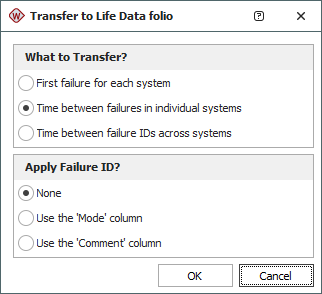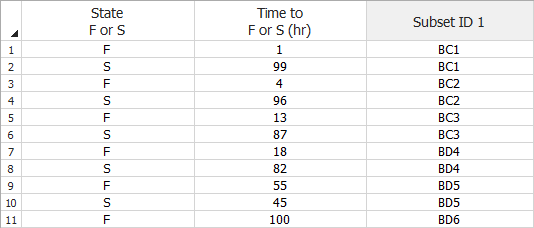Transfer Data to a Life Data Folio
For reliability growth data analysis only.
You can transfer data from a reliability growth analysis (RGA) folio to a life data folio. This option is available for time-to-failure data (except Multiple Systems – Known Operating Times), multi-phase data (except Mixed Data) and fielded data.
To transfer your reliability growth analysis data, first calculate the parameters of the data set, and then choose Growth Data > Transfer Data > Transfer to Life Data folio or click the icon on the Main page of the control panel.
![]()
The Transfer to Life Data folio window appears, as shown next. The options that are available will depend on the type of reliability growth analysis data sheet and model you are using.

- What to Transfer?
specifies how your reliability growth analysis data will be
handled in the life data folio.
- First failure for each system transfers only the first failure time of each system in the reliability growth analysis data sheet. Choose this option if you wish to use the life data folio to fit a life distribution to the first times to failure and calculate the reliability (i.e., probability of operating without failure for a period of time) of the system.
- Time between failures
in individual systems transfers all the failure
times of each system in the reliability growth analysis
data sheet. Although it is generally not recommended to
fit a life distribution to repairable systems data, you
might choose this option if you wish to use the life data
folio to fit a distribution to the data set for simulation
in BlockSim, ReliaSoft's system
reliability and maintainability analysis software.
If the failure times in the data sheet are cumulative, then the process converts the times into their equivalent non-cumulative failure times (because data entry in the life data folio is always non-cumulative). If the data in the reliability growth analysis data sheet are already non-cumulative, then no conversion will occur and the failure times that are transferred will appear as they do in the reliability growth analysis data sheet. - Time between failure
IDs across systems transfers all the failure times
in the reliability growth analysis data sheet based on
the unique failure modes in each system (you will need
to select one of the options in the Apply Failure ID area
to serve as the identifier for the failure modes). Choose
this option if you wish to use the life data folio to
fit a distribution to each failure mode (assuming that
the systems are the lowest repairable units).
If a failure mode did not occur in a particular system, then it will be treated as a suspension for that system. Similar to the previous option, if the failure times are cumulative, the process converts the data into their equivalent non-cumulative failure times; if the data are already non-cumulative, then no data conversion will occur.
- Apply Failure ID?
specifies how each data point in the life data sheet will
be grouped into subsets:
- The None option does not group the data points in the life data sheet.
- The Use the "Mode" column option is available only when using the Crow Extended or Crow Extended - Continuous Evaluation models. It transfers the combined information from the Classification and Mode columns in the reliability growth analysis data sheet to the Subset ID column in the life data folio. For example, for a reliability growth analysis data point that has the classification "BD" for mode "100," that data point will be categorized as part of subset "BD100" in the life data folio.
- The Use the "Comment" column option uses any text/values that were entered in the Comments column of the reliability growth analysis data sheet to group the data points in the life data folio.
A Note About Suspension Times in the Transferred Data
When you select to apply a failure ID, all subsets are assumed to end at the same time. For example, if you have two systems where the observation period for System 1 ended at 100 hours and for System 2 at 150 hours, then the transferred data for System 1 will automatically include a suspension time that covers the difference between the end times of the two systems.
Note that if the data were cumulative, then the suspension time would be the difference between the last failure time for System 1 and the last failure time for System 2 (e.g., 150 - 100 = 50 hours), but if the reliability growth analysis data were non-cumulative, then the suspension time would be the difference between the last failure time for system 1 and the total test duration (e.g., if the observation period ended at 250 hours, then the suspension time would be 250 - 100 = 150 hours).
Examples
The following examples show pictures of how data from a cumulative Failure Times data sheet may be transferred to a life data folio. Here is the original reliability growth analysis data.

Reliability Growth Failure Times data sheet (cumulative)
Example 1: Here is the data set transferred using the "Time between failures in individual systems" option with no failure ID applied. The cumulative times have been converted to non-cumulative. All failure times are transferred, but the failure mode is not identified.

Example 2: Here is the data set transferred using the "Time between failures in individual systems" option and the "Use the Mode column" option. The cumulative times have been converted to non-cumulative. The failure times are grouped into subsets based on the combined information from the Classification and Mode columns in the growth data sheet. The suspension data are added automatically to ensure that all the subsets have the same termination time.

Example 3: Here is the data set transferred using the "Time between failures in individual systems" option and the "Use the Comment column" option. The results are the same as example 2, except that the failure IDs came from the Comments column in the growth data sheet.
